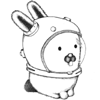keyboard man page on Plan9
[printable version]
KEYBOARD(6) KEYBOARD(6)
NAME
keyboard - how to type characters
DESCRIPTION
Keyboards are idiosyncratic. It should be obvious how to type ordinary
ASCII characters, backspace, tab, escape, and newline. In Plan 9, the
key labeled Return or Enter generates a newline (0x0A); if there is a
key labeled Line Feed, it generates a carriage return (0x0D); Plan 9
eschews CRLFs. All control characters are typed in the usual way; in
particular, control-J is a line feed and control-M a carriage return.
On the PC and some other machines, the key labeled Caps Lock acts as an
additional control key.
The delete character (0x7F) may be generated by a different key, one
near the extreme upper right of the keyboard. On the Next it is the
key labeled (not the asterisk above the 8). On the SLC and Sparcsta‐
tion 2, delete is labeled Num Lock (the key above Backspace labeled
Delete functions as an additional backspace key). On the other key‐
boards, the key labeled Del or Delete generates the delete character.
The view character (0x80), used by rio(1), acme(1), and sam(1), causes
windows to scroll forward. It is generally somewhere near the lower
right of the main key area. The scroll character is generated by the
VIEW key on the Gnot, the Alt Graph key on the SLC, and the arrow key ↓
on the other terminals. As a convenience for sloppy typists, some pro‐
grams interpret → and ← keys, which lie on either side of ↓, as view
keys as well. The arrow key ↑ scrolls backward.
Characters in Plan 9 are runes (see utf(6)). Any rune can be typed
using a compose key followed by several other keys. The compose key is
also generally near the lower right of the main key area: the NUM PAD
key on the Gnot, the Alternate key on the Next, the Compose key on the
SLC, the Option key on the Magnum, and either Alt key on the PC. After
typing the compose key, type a capital and exactly four hexadecimal
characters (digits and to to type a single two-byte rune with the value
represented by the typed number. Type a lower case and exactly UTF‐
max*2 hexadecimal characters to type a single UTFmax bytes rune. There
are shorthands for many characters, comprising the compose key followed
by a two- or three-character sequence. There are several rules guiding
the design of the sequences, as illustrated by the following examples.
The full list is too long to repeat here, but is contained in the file
in a format suitable for grep(1) or look(1).
A repeated symbol gives a variant of that symbol, e.g., ??
yields ¿.
ASCII digraphs for mathematical operators give the corresponding
operator, e.g., <= yields ≤.
Two letters give the corresponding ligature, e.g., AE yields Æ.
Mathematical and other symbols are given by abbreviations for
their names, e.g., pg yields ¶.
Chess pieces are given by a w or b followed by a letter for the
piece (k for king, q for queen, r for rook, n for knight, b for
bishop, or p for pawn), e.g., wk for a white king.
Greek letters are given by an asterisk followed by a correspond‐
ing latin letter, e.g., *d yields δ.
Cyrillic letters are given by an at sign followed by a corre‐
sponding latin letter or letters, e.g., @ya yields я.
Script letters are given by a dollar sign followed by the corre‐
sponding regular letter, e.g., $F yields ℱ.
A digraph of a symbol followed by a letter gives the letter with
an accent that looks like the symbol, e.g., ,c yields ç.
Two digits give the fraction with that numerator and denomina‐
tor, e.g., 12 yields ½.
The letter s followed by a character gives that character as a
superscript, e.g., s1 yields ⁱ. These characters are taken from
the Unicode block 0x2070; the 1, 2, and 3 superscripts in the
Latin-1 block are available by using a capital S instead of s.
Sometimes a pair of characters give a symbol related to the
superimposition of the characters, e.g., cO yields ©.
A mnemonic letter followed by $ gives a currency symbol, e.g.,
l$ yields £.
Note the difference between ß (ss) and µ (micron) and the Greek β and
μ.
FILES
/lib/keyboard
sorted table of characters and keyboard sequences
SEE ALSO
intro(1), ascii(1), tcs(1), acme(1), rio(1), sam(1), cons(3), utf(6)
KEYBOARD(6)
[top]
_ _ _
| | | | | |
| | | | | |
__ | | __ __ | | __ __ | | __
\ \| |/ / \ \| |/ / \ \| |/ /
\ \ / / \ \ / / \ \ / /
\ / \ / \ /
\_/ \_/ \_/
More information is available in HTML format for server Plan9
List of man pages available for Plan9
Copyright (c) for man pages and the logo by the respective OS vendor.
For those who want to learn more, the polarhome community provides shell access and support.
[legal]
[privacy]
[GNU]
[policy]
[cookies]
[netiquette]
[sponsors]
[FAQ]
Polarhome, production since 1999.
Member of Polarhome portal.
Based on Fawad Halim's script.
....................................................................
|
|
Vote for polarhome

|


